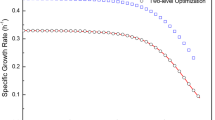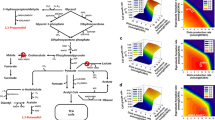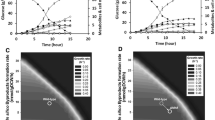Abstract
Although 1,3-propanediol (1,3-PD) is usually considered an anaerobic fermentation product from glycerol by Klebsiella pneumoniae, microaerobic conditions proved to be more conducive to 1,3-PD production. In this study, a genome-scale metabolic model (GSMM) specific to K. pneumoniae KG2, a high 1.3-PD producer, was constructed. The iZY1242 model contains 2090 reactions, 1242 genes and 1433 metabolites. The model was not only able to accurately characterise cell growth, but also accurately simulate the fed-batch 1,3-PD fermentation process. Flux balance analyses by iZY1242 was performed to dissect the mechanism of stimulated 1,3-PD production under microaerobic conditions, and the maximum yield of 1,3-PD on glycerol was 0.83 mol/mol under optimal microaerobic conditions. Combined with experimental data, the iZY1242 model is a useful tool for establishing the best conditions for microaeration fermentation to produce 1,3-PD from glycerol in K. pneumoniae.






Similar content being viewed by others
Data availability
The data that supports the findings of this study are available in the supplementary material of this article.
References
Jha V, Purohit H, Dafale NA (2021) Revealing the potential of Klebsiella pneumoniae PVN-1 for plant beneficial attributes by genome sequencing and analysis. 3 Biotech 11:473
Martin RM, Bachman MA (2018) Colonization, infection, and the accessory genome of Klebsiella pneumoniae. Front Cell Infect Microbiol 8:4
Kaur G, Srivastava AK, Chand S (2012) Advances in biotechnological production of 1,3-propanediol. Biochem Eng J 64:106–118
Dobson R, Gray V, Rumbold K (2012) Microbial utilization of crude glycerol for the production of value-added products. J Ind Microbiol Biotechnol 39:217–226
Liu H, Xu Y, Zheng Z, Liu D (2010) 1,3-Propanediol and its copolymers: research, development and industrialization. Biotechnol J 5:1137–1148
Wang XL, Zhou JJ, Shen JT, Zheng YF, Sun YQ, Xiu ZL (2020) Sequential fed-batch fermentation of 1,3-propanediol from glycerol by Clostridium butyricum DL07. Appl Microbiol Biotechnol 104:9179–9191
Avci FG, Huccetogullari D, Azbar N (2014) The effects of cell recycling on the production of 1,3-propanediol by Klebsiella pneumoniae. Bioprocess Biosyst Eng 37:513–519
Lee CS, Aroua MK, Daud WMAW, Cognet P, Peres-Lucchese Y, Fabre PL, Reynes O, Latapie L (2015) A review: Conversion of bioglycerol into 1,3-propanediol via biological and chemical method. Renew Sustain Energy Rev 42:963–972
Ju JH, Wang D, Heo SY, Kim MS, Seo JW, Kim YM, Kim DH, Kang SA, Kim CH, Oh BR (2020) Enhancement of 1,3-propanediol production from industrial by-product by Lactobacillus reuteri CH53. Microb Cell Fact 19:6
Jolly J, Hitzmann B, Ramalingam S, Ramachandran KB (2014) Biosynthesis of 1,3-propanediol from glycerol with Lactobacillus reuteri: effect of operating variables. J Biosci Bioeng 118:188–194
Jeng WY, Panjaitan NSD, Horng YT, Chung WT, Chien CC, Soo PC (2017) The negative effects of KPN00353 on glycerol kinase and microaerobic 1,3-propanediol production in Klebsiella pneumoniae. Front Microbiol 8:2441
Zhu C, Fang B, Wang S (2016) Effects of culture conditions on the kinetic behavior of 1,3-propanediol fermentation by Clostridium butyricum with a kinetic model. Bioresour Technol 212:130–137
Gungormusler-Yilmaz M, Cicek N, Levin DB, Azbar N (2016) Cell immobilization for microbial production of 1,3-propanediol. Crit Rev Biotechnol 36:482–494
Celinska E, Drozdzynska A, Jankowska M, Bialas W, Czaczyk K, Grajek W (2015) Genetic engineering to improve 1,3-propanediol production in an isolated Citrobacter freundii strain. Process Biochem 50:48–60
Chen X, Xiu Z, Wang J, Zhang D, Xu P (2003) Stoichiometric analysis and experimental investigation of glycerol bioconversion to 1,3-propanediol by Klebsiella pneumoniae under microaerobic conditions. Enzyme Microb Technol 33:386–394
Cheng KK, Liu HJ, Liu DH (2005) Multiple growth inhibition of Klebsiella pneumoniae in 1,3-propanediol fermentation. Biotechnol Lett 27:19–22
Huang H, Gong CS, Tsao GT (2002) Production of 1,3-propanediol by Klebsiella pneumoniae. Appl Biochem Biotechnol 98–100:687–698
Sarathy C, Breuer M, Kutmon M, Adriaens ME, Evelo CT, Arts ICW (2021) Comparison of metabolic states using genome-scale metabolic models. PLoS Comput Biol 17:e1009522
Huang M, Zhao Y, Li R, Huang W, Chen X (2020) Improvement of l-arginine production by in silico genome-scale metabolic network model guided genetic engineering. 3 Biotech 10:126
He M, Wen J, Yin Y, Wang P (2021) Metabolic engineering of Bacillus subtilis based on genome-scale metabolic model to promote fengycin production. 3 Biotech 11:448
O’Brien EJ, Lerman JA, Chang RL, Hyduke DR, Palsson BO (2013) Genome-scale models of metabolism and gene expression extend and refine growth phenotype prediction. Mol Syst Biol 9:693
Orth JD, Thiele I, Palsson BO (2010) What is flux balance analysis? Nat Biotechnol 28:245–248
Fouladiha H, Marashi SA, Torkashvand F, Mahboudi F, Lewis NE, Vaziri B (2020) A metabolic network-based approach for developing feeding strategies for CHO cells to increase monoclonal antibody production. Bioprocess Biosyst Eng 43:1381–1389
Bideaux C, Montheard J, Cameleyre X, Molina-Jouve C, Alfenore S (2016) Metabolic flux analysis model for optimizing xylose conversion into ethanol by the natural C5-fermenting yeast Candida shehatae. Appl Microbiol Biotechnol 100:1489–1499
Agren R, Otero JM, Nielsen J (2013) Genome-scale modeling enables metabolic engineering of Saccharomyces cerevisiae for succinic acid production. J Ind Microbiol Biotechnol 40:735–747
Mesquita TJB, Sargo CR, Fuzer JRN, Paredes SAH, Giordano RC, Horta ACL, Zangirolami TC (2019) Metabolic fluxes-oriented control of bioreactors: a novel approach to tune micro-aeration and substrate feeding in fermentations. Microb Cell Fact 18:150
Garcia-Albornoz MA, Nielsen J (2013) Application of genome-scale metabolic models in metabolic engineering. Ind Biotechnol 9:203–214
Nanda P, Patra P, Das M, Ghosh A (2020) Reconstruction and analysis of genome-scale metabolic model of weak Crabtree positive yeast Lachancea kluyveri. Sci Rep 10:16314
Zhu C, Jiang X, Zhang Y, Lin J, Fu S, Gong H (2015) Improvement of 1,3-propanediol production in Klebsiella pneumoniae by moderate expression of puuC (encoding an aldehyde dehydrogenase). Biotechnol Lett 37:1783–1790
Cui YL, Zhou JJ, Gao LR, Zhu CQ, Jiang X, Fu SL, Gong H (2014) Utilization of excess NADH in 2,3-butanediol-deficient Klebsiella pneumoniae for 1,3-propanediol production. J Appl Microbiol 117:690–698
Liao YC, Huang TW, Chen FC, Charusanti P, Hong JS, Chang HY, Tsai SF, Palsson BO, Hsiung CA (2011) An experimentally validated genome-scale metabolic reconstruction of Klebsiella pneumoniae MGH 78578, iYL1228. J Bacteriol 193:1710–1717
Reed JL, Vo TD, Schilling CH, Palsson BO (2003) An expanded genome-scale model of Escherichia coli K-12 (iJR904 GSM/GPR). Genome Biol 4:R54
Camacho C, Coulouris G, Avagyan V, Ma N, Papadopoulos J, Bealer K, Madden TL (2009) BLAST+: architecture and applications. BMC Bioinform 10:421
Wang H, Marcisauskas S, Sanchez BJ, Domenzain I, Hermansson D, Agren R, Nielsen J, Kerkhoven EJ (2018) RAVEN 2.0: a versatile toolbox for metabolic network reconstruction and a case study on Streptomyces coelicolor. PLoS Comput Biol 14:1006541
Henry CS, DeJongh M, Best AA, Frybarger PM, Linsay B, Stevens RL (2010) High-throughput generation, optimization and analysis of genome-scale metabolic models. Nat Biotechnol 28:977–982
King ZA, Lu J, Drager A, Miller P, Federowicz S, Lerman JA, Ebrahim A, Palsson BO, Lewis NE (2016) BiGG models: a platform for integrating, standardizing and sharing genome-scale models. Nucl Acids Res 44:D515-522
Norsigian CJ, Attia H, Szubin R, Yassin AS, Palsson BO, Aziz RK, Monk JM (2019) Comparative genome-scale metabolic modeling of metallo-beta-lactamase-producing multidrug-resistant Klebsiella pneumoniae clinical isolates. Front Cell Infect Microbiol 9:161
Henry CS, Rotman E, Lathem WW, Tyo KE, Hauser AR, Mandel MJ (2017) Generation and validation of the iKp1289 metabolic model for Klebsiella pneumoniae KPPR1. J Infect Dis 215:S37–S43
Heirendt L, Arreckx S, Pfau T, Mendoza SN, Richelle A, Heinken A, Haraldsdottir HS, Wachowiak J, Keating SM, Vlasov V, Magnusdottir S, Ng CY, Preciat G, Zagare A, Chan SHJ, Aurich MK, Clancy CM, Modamio J, Sauls JT, Noronha A, Bordbar A, Cousins B, El Assal DC, Valcarcel LV, Apaolaza I, Ghaderi S, Ahookhosh M, Ben Guebila M, Kostromins A, Sompairac N, Le HM, Ma D, Sun YK, Wang L, Yurkovich JT, Oliveira MAP, Vuong PT, El Assal LP, Kuperstein I, Zinovyev A, Hinton HS, Bryant WA, Artacho FJA, Planes FJ, Stalidzans E, Maass A, Vempala S, Hucka M, Saunders MA, Maranas CD, Lewis NE, Sauter T, Palsson BO, Thiele I, Fleming RMT (2019) Creation and analysis of biochemical constraint-based models using the COBRA Toolbox vol 3.0. Nat Protoc 14:639–702
O’Brien EJ, Monk JM, Palsson BO (2015) Using genome-scale models to predict biological capabilities. Cell 161:971–987
Shakeri-Garakani A, Brinkkotter A, Schmid K, Turgut S, Lengeler JW (2004) The genes and enzymes for the catabolism of galactitol, d-tagatose, and related carbohydrates in Klebsiella oxytoca M5a1 and other enteric bacteria display convergent evolution. Mol Genet Genomics 271:717–728
Shu HY, Fung CP, Liu YM, Wu KM, Chen YT, Li LH, Liu TT, Kirby R, Tsai SF (2009) Genetic diversity of capsular polysaccharide biosynthesis in Klebsiella pneumoniae clinical isolates. Microbiology (Reading) 155:4170–4183
Pan YJ, Lin TL, Chen CT, Chen YY, Hsieh PF, Hsu CR, Wu MC, Wang JT (2015) Genetic analysis of capsular polysaccharide synthesis gene clusters in 79 capsular types of Klebsiella spp. Sci Rep 5:15573
Zhou X, Chu Q, Li S, Yang M, Bao Y, Zhang Y, Fu S, Gong H (2022) A new and effective genes-based method for phylogenetic analysis of Klebsiella pneumoniae. Infect Genet Evol 100:105275
Pan DT, Wang XD, Shi HY, Yuan DC, Xiu ZL (2018) Dynamic flux balance analysis for microbial conversion of glycerol into 1,3-propanediol by Klebsiella pneumoniae. Bioprocess Biosyst Eng 41:1793–1805
Sarma S, Anand A, Dubey VK, Moholkar VS (2017) Metabolic flux network analysis of hydrogen production from crude glycerol by Clostridium pasteurianum. Bioresour Technol 242:169–177
Chen X, Zhang DJ, Qi WT, Gao SJ, Xiu ZL, Xu P (2003) Microbial fed-batch production of 1,3-propanediol by Klebsiella pneumoniae under micro-aerobic conditions. Appl Microbiol Biotechnol 63:143–146
Supaporn P, Yeom SH (2018) Statistical optimization of 1,3-propanediol (1,3-PD) production from crude glycerol by considering four objectives: 1,3-PD concentration, yield, selectivity, and productivity. Appl Biochem Biotechnol 186:644–661
Cheng KK, Liu DH, Sun Y, Liu WB (2004) 1,3-Propanediol production by Klebsiella pneumoniae under different aeration strategies. Biotechnol Lett 26:911–915
Zeng AP, Biebl H, Schlieker H, Deckwer WD (1993) Pathway analysis of glycerol fermentation by Klebsiella pneumoniae: regulation of reducing equivalent balance and product formation. Enzyme Microb Technol 15:770–779
Acknowledgements
This work was supported by the National Natural Science Foundation of China under Grant No. 31271862.
Author information
Authors and Affiliations
Contributions
YZ and HG conceived and designed the study. YZ constructed the model. YZ, WT and JT implemented the experiment. YZ, BL and LG collected the background information. YZ, MY, YB and SF checked the data of this study. YZ and HG drafted and edited the manuscript. All authors reviewed and approved the final manuscript.
Corresponding author
Ethics declarations
Conflict of interest
The authors declare that they have no conflict of interest.
Consent for publication
All authors agreed with this publication.
Ethical approval
For this type of study, ethical approval was not needed.
Additional information
Publisher's Note
Springer Nature remains neutral with regard to jurisdictional claims in published maps and institutional affiliations.
Supplementary Information
Below is the link to the electronic supplementary material.
Supplementary file 1. Table S1
: M9 minimal medium composition in silico. (XLSX 11 KB)
Supplementary file 2. Table S2
: Shake flask culture medium composition in silico. (XLSX 11 KB)
Supplementary file 3. Table S3
: The results of Biolog Phenotypic Microarray assay. (XLSX 19 KB)
Supplementary file 4. Table S4
: Reactions and metabolites added to iZY1242 model that not present in BIGG database before. (XLSX 10 KB)
Supplementary file 5. Table S5
: The flowchart for the construction of iZY1242 model. (XLSX 15 KB)
Supplementary file 6. Data Sheet 1
: (ZIP 964KB)
Rights and permissions
Springer Nature or its licensor (e.g. a society or other partner) holds exclusive rights to this article under a publishing agreement with the author(s) or other rightsholder(s); author self-archiving of the accepted manuscript version of this article is solely governed by the terms of such publishing agreement and applicable law.
About this article
Cite this article
Zhang, Y., Yang, M., Bao, Y. et al. A genome-scale metabolic model of the effect of dissolved oxygen on 1,3-propanediol fermentation by Klebsiella pneumoniae. Bioprocess Biosyst Eng 46, 1319–1330 (2023). https://doi.org/10.1007/s00449-023-02899-w
Received:
Accepted:
Published:
Issue Date:
DOI: https://doi.org/10.1007/s00449-023-02899-w




